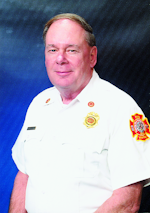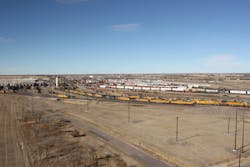Hazmat Studies: Protecting the World's Biggest Railroad Yard
Bailey Rail Yard in Nebraska, on the west side of North Platte, is the largest railroad classification yard in the world. Named in honor of former Union Pacific Railroad President Edd H. Bailey, the yard covers 2,850 acres with a total length of eight miles, well beyond the borders of North Platte, a community of 24,500 people in western Nebraska. Placed end to end, railroad track within Bailey would reach 315 miles and cover the distance between North Platte east to Omaha, on the Iowa border along the Missouri River.
Omaha is the location of Union Pacific’s world headquarters. Every 24 hours, 10,000 railroad cars are handled in Bailey. North Platte is home to 2,600 Union Pacific workers, including those who work in the yard and shops and those who operate over-the-road trains. Union Pacific routes range from Chicago, IL; Memphis, TN; New Orleans, LA; and Milwaukee, WI, on the east, to Seattle, WA; and Oakland, Los Angeles and Long Beach, CA, on the West Coast. Bailey does not have a fire brigade or hazardous materials response capability in house, so the North Platte Fire Department handles all fires and hazmat emergencies. Union Pacific contracts with a clean-up company to deal with non-emergency hazardous materials spills and clean-up of spills handled by the fire department.
The Union Pacific, a part of the transcontinental Railroad, is the largest railroad in North America. Union Pacific is celebrating its 150th anniversary. During World War II, the North Platte Canteen operated by volunteers and paid for totally by private funds served more than 6 million members of the armed forces during 10-minute troop train stops in town. During that short amount of time, service personnel were given food, magazines and newspapers to take with them. North Platte was also home to William F. “Buffalo Bill” Cody, who organized his famous Wild West Show from his ranch north of Bailey. His show was transported via rail and wagon.
Early fire protection
North Platte’s first organized fire protection was a volunteer fire brigade organized shortly after the arrival of the Union Pacific in November 1866. Initial membership included 12 employees of the railroad who primarily responded to prairie fires (to become a member, a volunteer was required to have his own leather bucket).
North Platte was incorporated as a city in 1874 and the fire brigade was reorganized into the North Platte Volunteer Fire Department in 1877. This department holds the distinction of being the oldest volunteer organization still in operation without any interruption from its inception in Lincoln County. In the early days, the volunteers were called to service by the sounding of the Union Pacific’s shop whistle. North Platte’s first career firefighter was Amiel Traub, who was appointed in 1918.
Today, the North Platte Fire Department is a combination organization with 42 career members and 27 volunteers. Volunteers train three times per month and are called to duty to provide additional personnel to supplement the career force for working structure fires and wildland fires. Volunteers also handle many of the fire prevention and public education functions of the department. They are organized into three shifts with a sergeant and second lieutenant for each shift. Career personnel work 24-hour shifts with a captain, lieutenant and three firefighters at Station 1 and a captain and three firefighters at Stations 2 and 3. A fire marshal, battalion chief and assistant chief round out the chief’s command staff.
The North Platte Fire Department is organized into three companies, which originated with the inception of the volunteer brigade in 1887. Buffalo Bill Hook and Ladder was started by a $100 donation from “Buffalo Bill” Cody. Other companies include the Cody Engine and Hinman Hose. Each company is comprised of 12 members; three members of each company serve as line and support officers. Richard Paul Pedersen Jr., a department member for 40 years and the chief for the past 20 years, recently retired. Dennis Thompson was promoted to take his place. The department covers an area of 369 square miles and responded to 3,288 alarms for service in 2012 – 519 fire alarms, 2,717 EMS calls and 52 hazmat calls. Response equipment includes three engine companies, one truck company, one heavy rescue/hazmat, one hazmat trailer, three medic units, a tanker, a light unit and grass rigs.
Hazmat coverage
Hazardous materials response began in North Platte in 1995-1996 with an operations-level capability. In 2002, a memorandum of understanding was established with the Nebraska Emergency Management Agency (NEMA) to transition from an operations-level team to a technician-level team. NEMA provided funding for the North Platte team and it became part of a regional system of teams in the state. When a regional team is activated by NEMA, those personnel are paid by the state as well as back-fill personnel to cover those sent on the hazmat response.
North Platte’s hazardous materials unit and its equipment are housed at Station 3, which is located at 3501 W. 2nd on the west side of North Platte near Bailey. The hazmat team is not dedicated, so personnel at Station 3 will staff the hazmat unit when such a call comes in. Their response vehicle doubles as a heavy rescue apparatus. Additional equipment is carried in a 20-foot cargo trailer. Also housed at Station 3 are a quint, two medic units and a grass rig. Hazmat responds to all hazardous materials incidents in the city, including fuel spills. Mutual aid is available from other regional hazmat teams in the state. All career firefighters on the North Platte Fire Department have been trained to the technician level. Volunteers are trained to the operations level. Each career firefighter goes through an 80-hour technician course and additional training is taken at Anniston, AL, for weapons of mass destruction, at the Pueblo, CO, tank car school and at Las Vegas, NV, for radiation training.
Equipment carried on the North Platte Fire Department hazmat response unit it typical for most hazardous materials teams. Respiratory protection is provided by MSA with 60-minute bottles for hazmat operations and N95 particulate-filtering facepiece respirators. Level A entry suits are Dupont Tychem and Level B are also made by Dupont. In-suit communication is accomplished with Motorola Throat Mike 1250s.
Hazmat exposure
North Platte is located on Interstate 80 and major highways U.S. 83 and U.S. 30. The Union Pacific has one main line and four additional lines that run through the heart of the city. Its team may also be dispatched to the Burlington Northern Santa Fe (BNSF) railroad line outside its district through the regional response system.
While many of the goods transported through Bailey are non-hazardous commodities, a wide variety of hazardous materials are shipped through the yard on a regular basis. Bailey is the major fixed hazardous materials exposure with rail cars of hazardous materials passing through the yard and 4 million gallons of diesel fuel storage capacity. Each year, the railroad uses approximately 254 million gallons of diesel in the rail yard. Fixed foam fire protection has been provided by Union Pacific for the diesel fuel storage tanks. Other fixed hazardous materials exposure in North Platte include a Walmart distribution center, a tank farm with five pipelines two miles south of town, a liquefied natural gas (LNG) facility at a truck stop, anhydrous ammonia, propane and agricultural chemicals.
The Union Pacific and the North Platte Fire Department work closely together to handle hazardous materials incidents as well as fire emergencies that may occur at Bailey. Union Pacific’s 2,700 personnel at Bailey have been trained to the hazmat awareness level. According to the North Platte Fire Department, Union Pacific has a great safety program for spill prevention. The fire department is responsible only for the stabilization of a hazmat incident in the rail yard. Pre-designated entry points have been identified at Bailey depending on the location of an incident for fire department and Union Pacific personnel. Kim Kelling, the hazardous materials manager for Union Pacific at Bailey, provides technical support, especially for tank car issues, as well as training for fire department personnel who respond to Bailey.
Recently, the Union Pacific purchased a foam trailer for use by the fire department and housed in a special building at Bailey. It carries 275 gallons of AFFF alcohol-type foam concentrate for ethanol and other polar solvent chemical fires and spills. Foam can be delivered from a master stream nozzle mounted on top of the trailer and two handlines. Approximately 300 feet of both 2½-inch and 1¼-inch handlines are carried on the trailer. Water can be supplied from a hydrant or fire apparatus or pumped from a 10,000-gallon portable tank or a static water source. If additional foam is needed, the Union Pacific has trailers in Salt Lake City, UT, and Des Moines, IA, that can be mobilized. Mutual aid from the Burlington Northern Santa Fe railroad also is available. Another 350 gallons of alcohol-type foam is stored at the North Platte airport.
In October 2012, the North Platte Fire Department and hazmat personnel responded to an oil storage tank fire at Bailey shortly after 1 P.M. The 15,000-gallon tank caught fire from a suspected short in a heater located just above the liquid level, which ignited the vapors in the tank. Pressure built up in the tank, causing a tank rupture and sending the top of the tank 150 feet away. There were no injuries, but minor damage occurred to a nearby building. The Union Pacific foam trailer was placed in operation to fight the fire with foam.
The Union Pacific provides approximately 2,500 emergency responders with training annually in the areas served by the railroad. In 2012, Union Pacific completed its 50th class at the Association of American Railroads Security and Emergency Response Training Center in Pueblo. They also participate in industry-wide whistle-stop training tours and Transportation Community Awareness and Emergency Response (TRANSCAER).
For additional information, contact North Platte Fire Department Chief Dennis Thompson at [email protected], 308-535-6761. Further information about the Union Pacific Railroad is available at www.up.com; and click on contact and you will see the name of a contact person in your area.
ROBERT BURKE, hazardous materials and fire protection consultant, a Firehouse® contributing editor, is a Certified Fire Protection Specialist (CFSP), Fire Inspector II, Fire Inspector III, Fire Investigator and Hazardous Materials Specialist, and has served on state and county hazmat teams. Burke is the author of the textbooks Hazardous Materials Chemistry for Emergency Responders, Counter-Terrorism for Emergency Responders, Fire Protection: Systems and Response and Hazmat Teams Across America. He can be contacted at [email protected].

Robert Burke
Robert Burke, who is a hazardous materials and fire protection consultant and who served as a Firehouse contributing editor, is a Certified Fire Protection Specialist (CFSP), Fire Inspector II, Fire Inspector III, Fire Investigator and Hazardous Materials Specialist. He has served on state and county hazmat teams. Burke is the author of the textbooks "Hazardous Materials Chemistry for Emergency Responders," "Counter-Terrorism for Emergency Responders," "Fire Protection: Systems and Response," "Hazmat Teams Across America" and "Hazmatology: The Science of Hazardous Materials."





